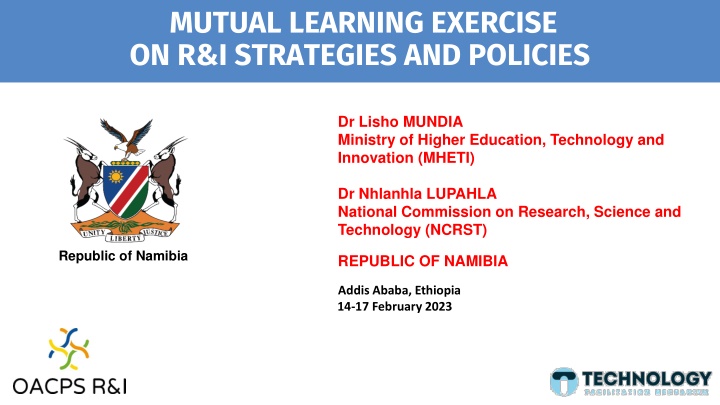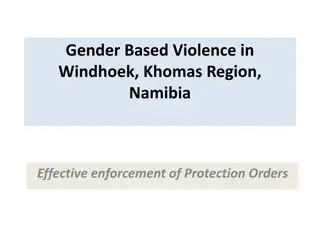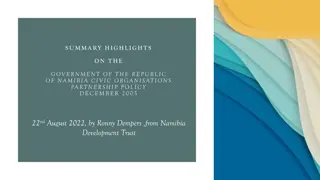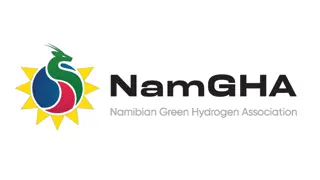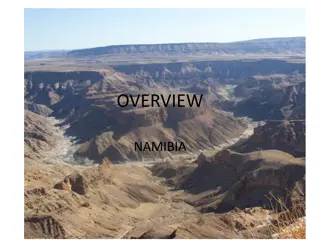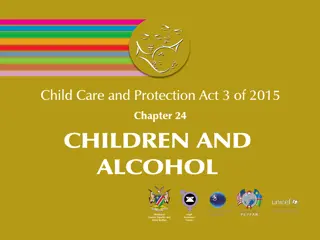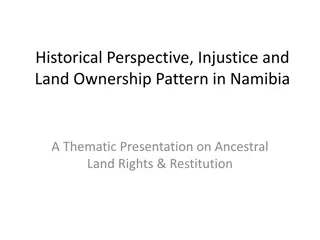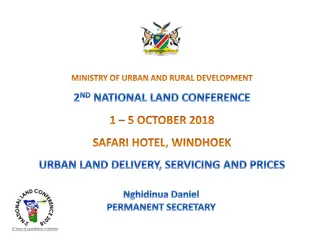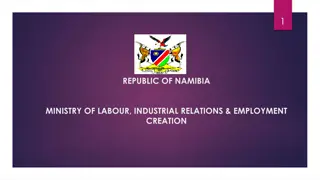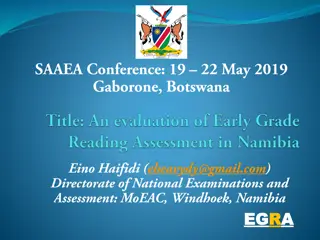R&I Strategies and Policies in Namibia
In-depth exploration of Namibia's research and innovation ecosystem, focusing on the review of science and technology policies, key stakeholders, and coordination efforts to align with global development goals. The presentation highlights the roles of institutions such as the Ministry of Higher Education, Technology, and Innovation, the National Commission on Research, Science, and Technology, and other relevant governmental bodies in shaping Namibia's R&I landscape.
Download Presentation

Please find below an Image/Link to download the presentation.
The content on the website is provided AS IS for your information and personal use only. It may not be sold, licensed, or shared on other websites without obtaining consent from the author.If you encounter any issues during the download, it is possible that the publisher has removed the file from their server.
You are allowed to download the files provided on this website for personal or commercial use, subject to the condition that they are used lawfully. All files are the property of their respective owners.
The content on the website is provided AS IS for your information and personal use only. It may not be sold, licensed, or shared on other websites without obtaining consent from the author.
E N D
Presentation Transcript
MUTUAL LEARNING EXERCISE ON R&I STRATEGIES AND POLICIES Dr Lisho MUNDIA Ministry of Higher Education, Technology and Innovation (MHETI) Dr Nhlanhla LUPAHLA National Commission on Research, Science and Technology (NCRST) Republic of Namibia REPUBLIC OF NAMIBIA Addis Ababa, Ethiopia 14-17 February 2023
Slide 1: Background and country context Objective: To provide context and an overview of the R&I Ecosystem By 2015, Namibia was one of the few countries that had not reviewed its science and technology policy since the first policy was developed in 1999. The review was needed for alignment and harmonization with new dynamics and treaties such as the Millennium Development Goals, World Summit on Sustainable Development recommendation, NEPAD Science and Technology Plan of Action and SADC protocol on Science, Technology and Innovation.
Slide 1: Background and country context Objective: To provide context and an overview of the R&I Ecosystem
Slide 2: Understanding the R&I (and STI) Ecosystem Objective: To understand the main R&I ecosystem actors and stakeholders in your country Research Centres MHETI Government Academia & TVET NCRST NSA Finance Informal Sector Industry
Slide 2: Understanding the R&I (and STI) Ecosystem INSTITUTION Ministry of Higher Education Technology and Innovation ROLE As custodian and implementing authority, the institution will provide technical and administrative leadership in collaboration with a cross section of stakeholders guided by the mandates and primary responsibilities of their respective Ministries, Offices and Agencies (OMAs), private sector institutions and civil society organizations. National Commission on Research, Science and Technology Provides for coordination, promotion and development of Science, technology and innovation and facilitate linkages/collaborations. Business and Intellectual Property Authority Focal point for registration of business and industrial property, and to administer and protect business and intellectual property rights. Communications Regulatory Authority of Namibia Contributes to the protection of Intellectual Property Rights in the electronic communication sector. Providing public/government land and infrastructure to companies that establish R&D and technology development facilities in the country. Local Authorities Ministries with STI components: Ministries of Agriculture, Water and Land Reform; Ministry of Defence and Veterans Affairs; Ministry of Fisheries and Marine Resources; Ministry of Health and Social Services; Ministry of Information and Communications Technology; Ministry of Mines and Energy and Ministry of Safety and Security Directorates responsible for RSTI and/or engineering to contribute to determining national R&D and innovation priorities for implementation programmes.
Slide 3: R&I Ecosystem Analysis - I Objective: To understand the strengths of the R&I ecosystem and opportunities for transformation through R&I policy Opportunities The country experiences political stability and relatively good governance; Namibia is an upper middle-income country with good macroeconomic conditions. The economy has performed relatively well over the past two decades despite shocks and a slowdown attributed to the global economic crisis of the past decade; Namibia has deepened its participation in the Southern Africa Development Community (SADC), AU and the United Nations (UN). It has also established numerous bilateral arrangements with many countries around the world; There has been a resurgence of attention to science, technology and innovation (STI) as critical components in national economic change and development. Challenges Limited human and institutional capacity; Limited investment in Research and Development (R&D) and low R&D rating internationally; Limited private sector participation in R&D within country; A weak entrepreneurial and innovation culture; Weak linkages between universities, R&D institutes and industry; Low level of a well-defined and coordinated information management system (IMS); Low level of reliable STI statistics and STI indicators and the incoherent reporting thereof; Lengthy policy gestation period
Slide 4: R&I Ecosystem Analysis - II Objective: To help identify and assess framework conditions that may foster or hinder transformative change through R&I policy In order to respond to challenges, MHETI, in collaboration with the NCRST, with key partners, in particular UNESCO, initiated a consultative process to review the NRST Policy of 1999, which led to the recently approved RNSTI Policy. The revised NSTI Policy was also formulated in such a way to align and to respond to key national, regional and international policy frameworks, strategies and legal instruments.
Slide 5: Transformation and Development Impacts Objective: To help establish links to the broader/global context of the SDGs # SDG INSTRUMENT AND PURPOSE Harambe prosperity plan ii: Social progression pillar 1 No poverty Zero deaths from hunger and poverty 2 Zero hunger 3 Good health and well being Improved access to health care (including covid-19 response) 4 Quality education Improved access to quality education and sports STI policy (2020-2030) Objective 4: to improve gender equality and mainstreaming in stem 5 Gender equality STI policy guiding principle 6: Sustainable development 6 Clean water and sanitation Improved access to clean water and sanitation facilities 7 Affordable energy Improved access to environmentally sound energy, and enhancing environmental sustainability
Slide 5: Transformation and Development Impacts Objective: To help establish links to the broader/global context of the SDGs # SDG INSTRUMENT AND PURPOSE 8 Decent Work And Economic Growth NDP5: transformation, environmental sustainability and good governance. Has four (4) pillars economic progression, social Economic Progression:diversify the economy from reliance on primary industries towards greater contribution of secondary and tertiary (less government services) industries to GDP. 9 Industry, Innovation And Infrastructure National Infrastructure Strategy (Draft) STI Policy Objective 8: infrastructure provision To improve research and innovation
Slide 5: Conclusion insights for MLE Objective: To help summarise the key messages and insights from your country presentation National Programme On Research, Science, Technology And Innovation: sets out the national direction on RSTI, reviews the previous NPRSTI, identifies shortcomings and priorities for RSTI and develops budget for calls to be issued for the entire period of the programme. 1. National Action Plan For STI Policy Implementation: IT is for the implementation of the NSTIP. It is developed through nation-wide consultations involving stakeholders from higher education institutions (HEIs), government ministries and agencies, regional authorities, research institutions, civil society and private sector. The NAP s overall objective is to fast-track the implementation and increase the effectiveness of the NSTIP. 1. 3. National Indicator Framework data for SDGs and RSSR (launched on 20 July 2022) available at: https://nsa.nsa.org.na/new_publications/sdg-ndp-indicator- framework-2019
Slide 6: References 1. Revised National Science, Technology And Innovation Policy (NSTIP) of 2020- 2030. Retrieved from: https://ncrst.na/wp-content/uploads/2021/10/NAM-STI- POLICY.pdf [accessed 12 February 2023]. 2. The https://nsa.nsa.org.na/new_publications/sdg-ndp-indicator-framework-2019 [accessed 12 February 2023]. National Indicator Framework. Retrieved from:
